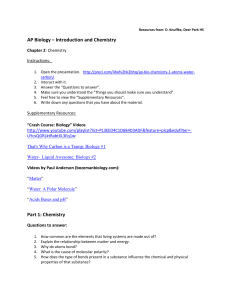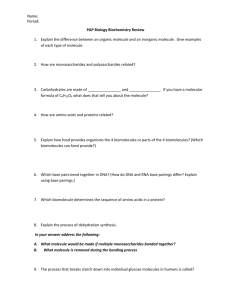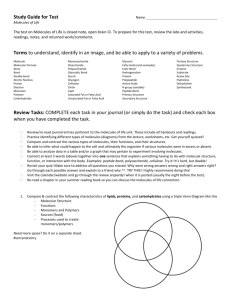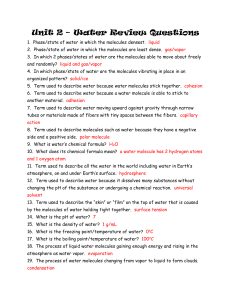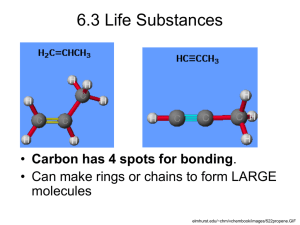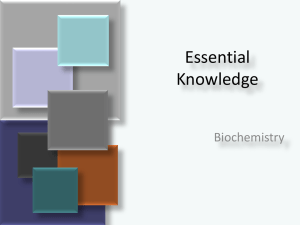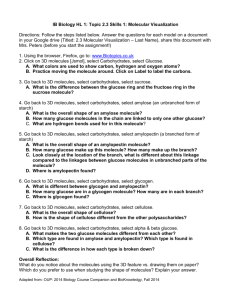Section 3.1 - Properties of Water
advertisement
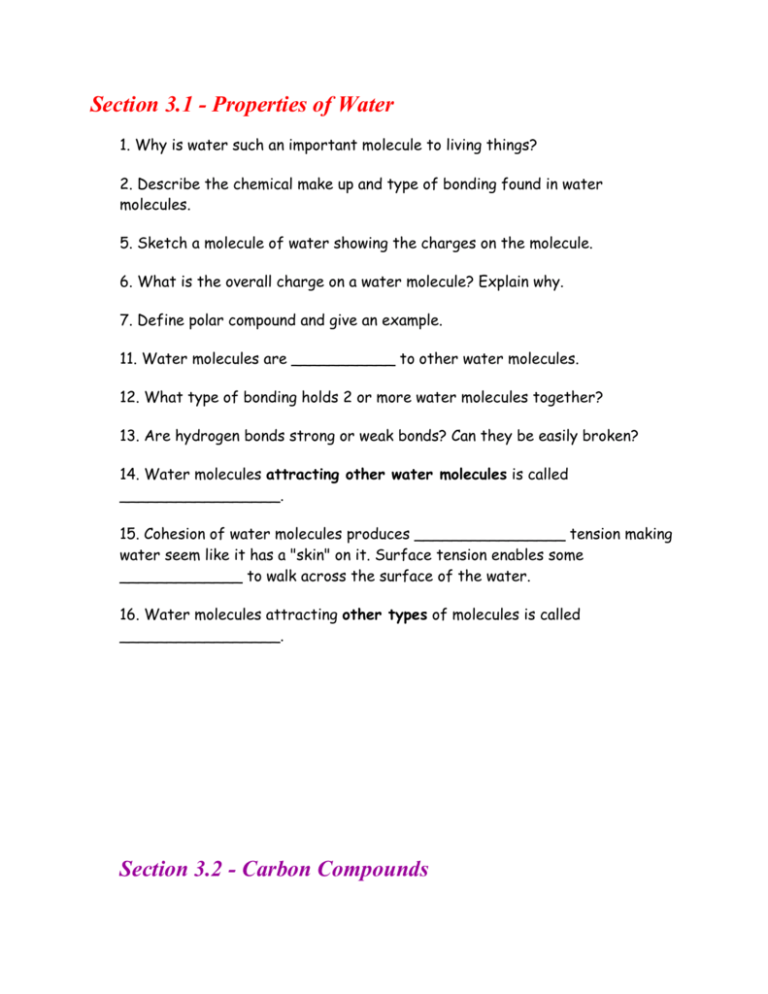
Section 3.1 - Properties of Water 1. Why is water such an important molecule to living things? 2. Describe the chemical make up and type of bonding found in water molecules. 5. Sketch a molecule of water showing the charges on the molecule. 6. What is the overall charge on a water molecule? Explain why. 7. Define polar compound and give an example. 11. Water molecules are ___________ to other water molecules. 12. What type of bonding holds 2 or more water molecules together? 13. Are hydrogen bonds strong or weak bonds? Can they be easily broken? 14. Water molecules attracting other water molecules is called _________________. 15. Cohesion of water molecules produces ________________ tension making water seem like it has a "skin" on it. Surface tension enables some _____________ to walk across the surface of the water. 16. Water molecules attracting other types of molecules is called _________________. Section 3.2 - Carbon Compounds 23. What is an organic compound? 24. Besides carbon, name 3 other elements that make up most organic compounds. 26. How many electrons are in the outermost energy level of carbon? How many does it need to have this energy level filled? 27. How many covalent bonds can carbon form? 29. How many electrons are being in a single covalent bond? double covalent bond? triple covalent bond? quadruple covalent bond? 32. Write the formula for these functional groups (use your textbook & handout) --- hydroxyl, carboxyl, phosphate group, amino group, and methyl group. 34. Large carbon molecules are built from smaller, simpler molecules called ____________. 35. Large carbon molecules made of monomers are called _______________. 36. What are large polymers called? 37. What type of reaction links monomers to make polymers? 38. Sketch a molecule of sucrose (table sugar) formed from condensation. 39. Condensation reactions involve the removal of a molecule of ____________. 40. What reaction is used to breakdown polymers? Is water added or removed? How does this compare to condensation? Section 3.3 - Macromolecules 44. Name the 4 main classes of macromolecules (organic molecules) & tell what 3 elements all of these contain. Carbohydrates store energy for organisms! 45. In what ratio are hydrogen & oxygen atoms in carbohydrates? 46. In what 3 forms do carbohydrates exist? 47. What are the monomers of carbohydrates called? What is their common name? Give the ratio of carbons, hydrogens, & oxygens. 48. Name the 3 MOST common monosaccharides. 51. What are double sugars called? Name & describe the process that forms them. 52. Name a disaccharide. 53. What forms a polysaccharide? Name a polysaccharide found in animals. Name one found in plants? 54. What chemical reaction formed these large molecule? What reaction would be needed to break these molecules? Proteins are used to build cells, & they act as enzymes! 57. What are the monomers of proteins called? How many are there? Name the 4 things bonded to the center carbon of this monomer. 58. The main difference among amino acids is their ___________ group. 59. Differences in R-groups give different proteins different ______________. 61. What do you call the covalent bonds that hold amino acids together? 62. Long chains of amino acids are called ___________________ and these join together to make a ________________. 64, What is the effect of temperature on protein shape? Give an example of this. 65. Most proteins act as catalysts or __________________ inside of cells. 66. The substance an enzyme is acting upon is called the _____________ and it must ______ into a place called the active site on the enzyme. 69. After the reaction, what happens to the products? Can the enzyme be reused & why? 70. Besides temperature, what else can effect how an enzyme works by changing the enzyme's shape? Can the reaction still take place? Lipids include fats that are used for long-term energy storage! 71. Are lipids polar or nonpolar? What happens to lipids when they are placed in water? 72. Compared to carbohydrates, what is true about the ratio of carbon & hydrogen atoms to oxygen atoms? 73. Most lipids are made of ______________ acids. What functional group is found on the head end of the molecule? Nucleic acids store genetic information for cells! 90. Give the name & abbreviation for 2 nucleic acids found in cells. 91. DNA and RNA are both examples of _____________ made of linked monomers called ________________. The instructions in these molecules is used to make ____________. 92. Name the 3 parts to a nucleotide then draw and label one.


